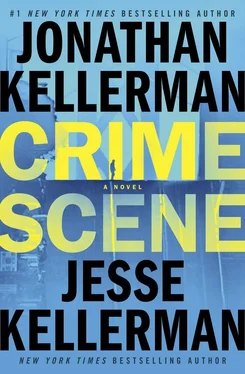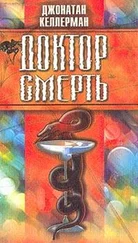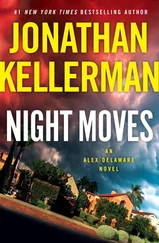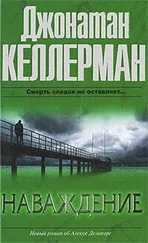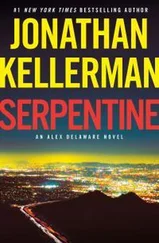Tatiana said the offender had been enrolled in one of her father’s research studies. What she’d left out, deliberately or not, was the nature of that research.
Rennert, it emerged, had built a career examining the effects of media violence on the developing brain. The theory appeared to be that exposing kids to graphic imagery harmed them in all sorts of ways: lessening their empathy, hindering their academic performance, and — his central theme — priming them to commit real-world violence. Perusing his abstracts on PubMed, I gathered he did stuff like show teenagers clips from slasher films while measuring their heart rates.
That sounded on par. During my senior year, when I suddenly had a bunch of free time, I’d volunteered for a handful of psych studies. I recalled a corkboard in the lobby of Tolman Hall, tabbed flyers promising free cookies in exchange for collaboratively building a tower of wooden blocks; five bucks to put on goofy stereoscopic glasses and follow the bouncing ball.
To earn course credit, rather than cash, you’d have to expend a little more effort. Code video, log data, help conduct the study itself. That was what Donna Zhao had been doing when she was murdered: working in Rennert’s lab, assisting with the experiment that would draw her killer into the building.
The Zhaos, Chinese nationals, had hired a San Francisco firm to represent them. The claim was that Rennert, his lab, and the institutions they belonged to had failed to properly evaluate the boy’s potential for real violence. By exposing him to violent stimuli, they had triggered an outburst that found the closest available target: Donna Zhao.
A settlement was reached in 1997.
Its terms were undisclosed.
Days later, Walter Rennert resigned his professorship.
There was no mention of him testifying.
The name Nicholas Linstad did not appear anywhere.
Turning my attention to Linstad, I found nothing, not even an obit or death notice.
That was as much as I could learn from the comfort of home. I shut my computer and went out for a run.
When it comes to the gentrification of Oakland, Lake Merritt is old news. Nestled in the northern half of the city, bounded by water and freeways, it lies apart from the truly mean streets, steadily absorbing the drip of wealth that filters down through the tony bedrock of Elmwood, Piedmont, Montclair. I’ve lived here long enough to witness the change, liquor stores evolving into purveyors of small-batch bitters.
Rough edges remain. Hand-grind spices and pour-over coffee and letterpress all you want. That dude by the off-ramp, with the cardboard sign and the starving Chihuahua in a backpack? He’s still on meth.
That day I took my usual route along the lake: down Bellevue, past the bonsai garden, and out toward the boating center, where a group of young, fit white people in ludicrously matching outfits dragged their scull toward water rich with chop. The setting sun did a good job of wiping the world clean. Geese, out in full force, honked obnoxious taunts. For decades they’d used the park as a migratory way station. They’d drop in for a few weeks, like ill-mannered relatives, before taking off for points south. In recent years, it had occurred to them that they liked it here just fine. Maybe they could take the pulse of the real estate market. Installing themselves on a permanent basis, they’ve gobbled up territory, dropping their waste indiscriminately, so that now the lawns consist of more slime than grass. Even for a neighborhood latecomer like me, it’s hard not to view them as a metaphor.
The breeze brought a tinkle of bells from Children’s Fairyland.
I jogged along, keeping an open mind.
When, precisely, had Donna Zhao’s killer been released from prison?
Where was he now?
Distracted, I strayed to the edge of the path. From my right came a rusty shriek and a blitz of dirty brown.
“Dammit.”
I sidestepped the charging goose, leaving it snapping at the air.
Reaching Broadway, I hopped from foot to foot, waiting for the light to change.
I had other questions, too: about the accidental death of Nicholas Linstad, and the lawsuit, and Walter Rennert’s experiment gone wrong. About Tatiana.
The WALK sign lit up. I put my head down and barreled into the wind to make it feel like I was going fast. With any luck I could catch the mushroom girl before she left.
On Thursday morning, Sergeant Vitti lumbered into the squad room. “Ladies and gentlemen, we have a winner.”
I minimized a window and swiveled around to accept his congratulations.
“Two weeks running,” Vitti said, pumping my arm. “Get this man a frickin cookie.”
“All gone,” Carmen Woolsey said.
“Get this man a cruller.”
Sully tossed a mini-packet of M&M’s on my desk.
“Good enough,” Vitti said. He thrust an imaginary microphone in my face. “Coach. Hey, Coach. Coach. What’s the secret to your success?”
I said, “At the present time I can’t reveal that information.”
Vitti chortled. “Lookit Bill Belichick here.”
A hail of boos.
“Don’t hate on excellence,” Vitti said. He grinned, grabbed my shoulders, and massaged them aggressively. He was a shoulder-kneader, the sergeant. “I’m coming for you this week. You know that, right? How’s that make you feel, Coach?”
“At the present time I can’t reveal that information.”
Vitti squeezed my chin, patted my cheek, and lumbered away, announcing as he went that rosters had to be in no later than five tomorrow, for five thirty kickoff.
Shupfer cast her eyes heavenward: Have mercy.
I watched Vitti disappear into his office, then reopened CME.
According to our system, Nicholas Linstad was a divorced white male, age forty-two.
His next of kin was his father, Herman Linstad, residing in Gottenborg, Sweden.
He had died on December 2, 2005, of an acute cerebral hemorrhage resulting from blunt trauma to the head.
The manner of death was accidental.
The coroner’s investigator was M. Ming.
I knew Ming in passing. One of the last civilian CIs, he’d retired long ago but was known to drop by the office every now and again. He and Shupfer were close. The M stood for Marlborough.
I emailed document storage.
Twenty-four hours later, a box arrived containing Linstad’s file, along with several dozen others. His was comparatively thick, containing the full autopsy protocol, a handful of photos, and portions of the Berkeley police report.
Paging through, I noted a number of superficial similarities to the Rennert case.
Linstad lived north of campus, on the upper floor of a duplex, the bottom half of which served as his office. An exterior staircase offered direct access to the living quarters. It was at the foot of these stairs that the body had been found, by the mail carrier, circa nine thirty a.m. In his narrative, Ming recorded intermittent rain on the preceding day, increasing throughout the night. Linstad’s hair and clothing were soaked. The wooden banister on the second-floor landing was rickety, and the door to the upstairs unit was slightly ajar. The interior showed some disorder but no definitive sign of a struggle. There were few furnishings and almost no clutter, which made it hard to tell. A single wineglass on the coffee table; another in the sink; a half-empty wine bottle sat on the counter, a second empty in the trash.
If you wanted to see similarities, you had to see differences, too.
Whereas Rennert’s body showed no cuts or abrasions, Linstad’s bore the hallmarks of a fall. Attempting to arrest his descent, he’d made a desperate grab at the duplex’s wooden siding, leaving deep gouges in the shingles, collecting splinters under his fingernails; tearing the right middle fingernail halfway off. Bruises ran down his spine; a long thin bruise marred his right flank, the likely result of slamming against the edge of a stair tread. Scrapes covered his knuckles, and there was blood on and around the bottommost steps, in enough quantity that it hadn’t washed away overnight. The pathologist concluded that the major trauma came from Linstad’s head hitting the pavement, rather than from an object. Toxicology gave a blood alcohol level of.11.
Читать дальше
